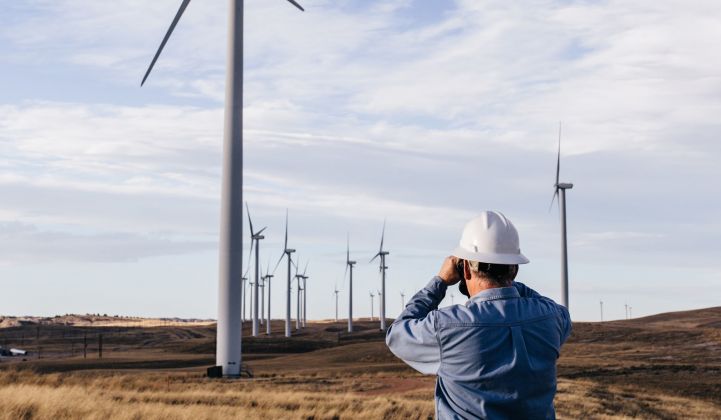For the first time, Pacific Northwest and Rocky Mountain utility PacifiCorp is planning to rely on massive amounts of solar PV and batteries, as well as wind power, for a large share of its long-term energy needs. The company also wants to shut down economically struggling coal plants years earlier than scheduled.
These are some of the highlights from PacifiCorp’s draft integrated resource plan filed on Thursday, laying out its investment targets through 2038. PacifiCorp’s IRP has become a major focus of clean energy advocates and climate change activists, given its potential to accelerate the Berkshire Hathaway-owned utility’s move away from fossil fuels and toward carbon-free alternatives.
The draft IRP would close five coal plants in Wyoming by 2028, instead of keeping most of them open through 2037 or later. This move is likely to face opposition from the coal-friendly state’s political leadership, including a newly passed law that would force PacifiCorp to find a buyer for its money-losing plants before shutting them down.
Still, PacifiCorp’s nearly year-long analysis has shown that keeping these coal plants open doesn’t align with its imperative of delivering reliable and low-cost energy to its six-state, 1.9-million-customer territory.
“This plan allows us to continue to deliver the reliable and low-cost energy our customers need as we embark on a phased and well-managed coal transition,” Rick Link, PacifiCorp’s vice president of resource planning and acquisitions, said in a Thursday conference call.
PacifiCorp’s draft IRP, which will now go through a stakeholder comment period in advance of its Oct. 18 filing deadline, calls for more than 3,500 megawatts of new wind generation by 2025, and more than 4,600 megawatts of new wind generation by 2038. Almost all of that is to be built in Wyoming.
To carry it to market, PacifiCorp’s IRP relies on the planned 400-mile Gateway South transmission line to connect southeastern Wyoming and northern Utah, augmenting the 140-mile Gateway West line now being built in Wyoming.
But the IRP also calls for nearly 3,000 megawatts of new solar by 2025 and more than 6,300 megawatts by 2038, along with nearly 600 megawatts of battery storage by 2025 and more than 2,800 megawatts by 2038. In fact, all of the storage planned by 2025 is to be paired with new solar, marking the first time that PacifiCorp has identified battery storage as part of a least-cost portfolio, Link noted.
That’s largely due to the tax benefits still available to storage added to solar systems earning the federal Investment Tax Credit, he said. But it’s also a testament to the value that batteries can provide solar PV farms in terms of firming its capacity factor, enhancing its flexibility and otherwise making it a more reliable resource for PacifiCorp, as we noted in a column in last month’s GTM Squared.
Here’s PacifiCorp’s solar-storage breakdown by state:
- 3,000 megawatts of new solar in Utah paired with 635 megawatts of battery storage, phased in between 2020 and 2037
- 1,415 megawatts of new solar in Wyoming paired with 354 megawatts of battery storage, phased in between 2024 and 2038
- 1,075 megawatts of new solar in Oregon paired with 244 megawatts of battery storage, phased in between 2020 and 2033
- 814 megawatts of new solar in Washington paired with 204 megawatts of battery storage, phased in between 2024 and 2036.
PacifiCorp will also rely on a significant amount of new natural-gas generation resources to meet its future goals. It anticipates launching all-source bids to procure the earliest rounds of resources it’s seeking, most likely in the 2021 timeframe, Link said.
The utility expects to see significant savings over the 20 years covered by its IRP, compared to various business-as-usual benchmarks used in its previous analyses. Its most recent analysis indicated that it could save nearly $600 million over 20 years, largely by replacing coal-fired power with low-cost renewables. But Link said it would be premature to assign a value to the current draft IRP’s plan, since the proper benchmark for calculating it will be different from previous ones.
As for PacifiCorp’s current fleet of 24 coal units, the draft IRP calls for retiring 16 of them by 2030 and 20 of them by 2038. These include several accelerated retirements:
- Jim Bridger 1 in 2023 instead of 2037
- Naughton 1 and 2 in 2025 instead of 2029
- Craig 2 in 2026 instead of 2034
- Colstrip 3 and 4 in 2027 instead of 2046
- Jim Bridger 2 in 2028 instead of 2037
But Senate File 159, passed with overwhelming support from Wyoming's Republican-controlled state legislature in March, will put barriers in front of these retirements. The law prohibits utilities from closing coal-fired power plants without first making a “good-faith effort” to find buyers that will continue operations — a challenging proposition, given that these are the worst-performing power plants in PacifiCorp’s portfolio.
Chad Teply, senior vice president for policy and business development, said that PacifiCorp is preparing to comply with the law in executing its first scheduled retirement of the Bridger 1 unit in 2023. The Wyoming Public Service Commission is in the midst of making rules to implement the law. Teply added, “We would foresee that Bridger Unit 1 retirement as the first opportunity to deploy and comply with Wyoming’s law to make that available to the market for sale, effectively.”
--
We're gathering industry views on how renewable integration, decarbonization, sector electrification and the growing need for increased capacity and flexibility are impacting electricity systems. Join us October 29-30 in Austin, TX at GTM's Power and Renewables Summit.




